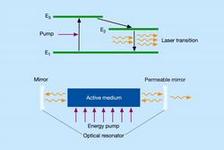Principle of a conventional quantum laser where the electrons are bound to atomic, molecular or solid-state energy levels (”bound-electron laser”).
The next big improvement in the performance of accelerator-based light sources is given by the free-electron laser. The main components of an FEL are an accelerator providing a bunched relativistic electron beam and an undulator magnet. In an FEL many electrons radiate coherently. The radiation power then grows quadratically with the number of these particles. For a typical number of 106 electrons in a coherence region, the FEL will yield a million times higher light output than an undulator in a synchrotron.
The word LASER is an acronym for Light Amplification by Stimulated Emission of Radiation. A conventional quantum laser consists of three basic components: a laser medium with at least three energy levels, an energy pump, and an optical resonator. Stimulated emission takes place between an excited state E2 and the ground state E1. A higher level E3 is needed to achieve a population inversion by pumping many electrons from E1 to E3 from where they make a fast transition to E2. The axis of the optical cavity defines the direction of the photon beam. In a mono-mode laser exactly one optical eigenmode of the cavity is excited. The photons in this mode are all in the same quantum state, and the probability for stimulated emission from E2 to E1 is proportional to the number of photons present in this state.
In a free-electron laser the role of the active laser medium and the energy pump are both taken over by the relativistic electron beam. The electrons are not bound to atomic, molecular or solid-state levels but are moving freely in vacuum. The pump source is the large kinetic energy of the electrons. Stimulated emission takes place from higher to lower kinetic energies under the action of an already existing light wave, e.g. from an optical laser.
The motion of the electrons on their slalom path produces a velocity component along the transverse electric field of the light wave, resulting in an energy exchange between the electrons and the light wave. Specifically, the coupling between the electron and the light wave is proportional to the electric field strength of the wave, and the FEL gain is proportional to the number of photons in the light wave. Hence one is well justified to speak of light amplification by stimulated emission of radiation when talking about a free-electron laser. Moreover, the light emerging from an FEL has the same properties as conventional laser light in that a huge number of coherent photons are contained in a single optical mode.
An FEL operating at infrared and optical wavelengths can be equipped with an optical resonator, but this is no longer possible if the wavelength is decreased below 100 nm, because here the reflectivity of metals and other mirror coatings drops quickly to zero at normal incidence. In the extreme-ultraviolet and X-ray regime a large laser gain has to be achieved in a single passage of a very long undulator magnet. The principle of Self-Amplified Spontaneous Emission (SASE) allows the realization of high-gain FELs at these short wavelengths.






